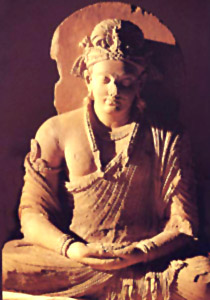 The first foreign invasion after the downfall of the Mauryas, who established their own Empire in India, was the Saka-Parthians. They were basically nomadic tribes who assimilated with Indian civilization gradually. As a result, their inferior level of culture was bound to be influenced by the civilization of the land they had conquered. Thus the history of the Saka-Parthian in India records the interesting story of the absorption of the virile and warlike people- the Sakas. It is not merely that the Saka Parthians were influenced by the Hindu Culture in India only. As they entered India by overthrowing the Indo-Greeks, they were also exposed to the superior culture of the Greeks. This is evident in the Saka coinage and the patronage to the Gandhara art and the relics of the Saka architecture and sculpture found in Taxila and other places of Gandhara.
The first foreign invasion after the downfall of the Mauryas, who established their own Empire in India, was the Saka-Parthians. They were basically nomadic tribes who assimilated with Indian civilization gradually. As a result, their inferior level of culture was bound to be influenced by the civilization of the land they had conquered. Thus the history of the Saka-Parthian in India records the interesting story of the absorption of the virile and warlike people- the Sakas. It is not merely that the Saka Parthians were influenced by the Hindu Culture in India only. As they entered India by overthrowing the Indo-Greeks, they were also exposed to the superior culture of the Greeks. This is evident in the Saka coinage and the patronage to the Gandhara art and the relics of the Saka architecture and sculpture found in Taxila and other places of Gandhara.
The essential cultural features of the Saka-Pahlava or the Saka Parthians were revealed from their art of coinage. The Saka-Pahlava rulers merely copied the Indo-Greek technique in the art of coinage without adding their own innovation. They continued to follow the Indo-Greek style of Greeks and Kharosti legends. The copper and the silver coins, which they used for their monetary transactions bore the essence of Indo-Greek style. Like the Indo-Greeks the Saka-Pahlavas did not issue any gold coins. They used the Greek legends extensively in the coins and also adapted the Indo-Greek vocabulary.
The Gandhara art, which originated during the period of the Yavanas or the Indo-Greeks, was enriched with nourishment by the Saka Parthians. The excavations at Taxila and other places pointed to the progress of sculpture and architecture in the Saka Parthian period. In respect to architecture, the general theme of the Saka-Parthian period seemed to be simple, chaste and unsophisticated. The royal palace at Sirkap was vast but there was absence of adornments and grandeur in the architecture of the palace. However the remains of the Buddhist Stupas and the temples of the Saka Parthian Age were constructed with signs of elaborate style. The great fire temple (Agni) of Taxila was a very imposing structure.
With the passage of time, the Saka-Parthian people in India gradually embraced the Indian names, customs and religious creeds. They established matrimonial relations with the Indians and began to shed their outlandish culture and identified themselves as the original inhabitants of India. Mahakshatrapa Rudramana established matrimonial relations with the house of Sattavahanas, Iksvhakus and the Lichachavis. Thus the alien Sakas were mixed with the Indian people. V.Smith has suggested that the ancestors of the modern Rajputs were Hinduised Sakas, who later came to be known as Kshatriyas.
The cultural idiom of the Saka-Parthian is revealed from their patronage towards Sanskrit Literature. According to Syvain Levi, "the Sbakar", a general comic character, found in Sanskrit dramas, developed due to the Saka influence. Bharat in his treatise of drama has referred to "Shakar", which was popularised by the Sakas. Moreover Indian classical music was enriched by the outlander Sakas. They introduced some alien "ragas" into Indian music. Matanga in his musical treatise, "Brihaddesi" has referred to a Mixed Saka raga. Indian Astronomy was also greatly enriched under Saka influence. During the Saka- Pahlava reign, Ujjaini became the centre of astronomical studies. The Sakas initiated the Kanishka era in 78 A.D., which came to be identified as the Saka era and later was recognised as the official era by the Government of India.
The Saka-Parthians introduced the system of Government in Northern India, based on the blending of Indo-Greek with the Parthian system. Like the Indo-Greeks, the Saka kings associated their successors with them as joint rulers. Following the Indo-Greek tradition, the Saka kings also mentioned the name of the senior king in the front of the coins and the junior kings on the reverse side. In provincial administration they continued the system of appointing Greek strategies in Northwest India. But in other parts of the country they introduced the famous Satrapal system of Parthia. The provincial governors were called `Meridarch`. They participated in administration with the amatyas and mahasenapatis. The Saka kings assumed high-sounding titles like Chakravarti, Adhiraja, Rajatiraja, Maharaja etc.



















